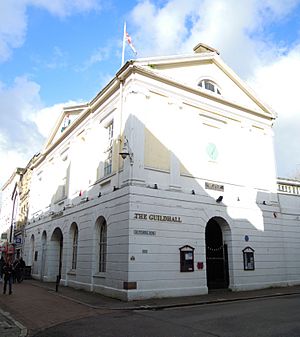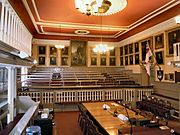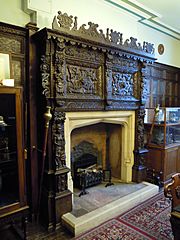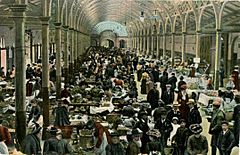Guildhall, Barnstaple facts for kids
Quick facts for kids Barnstaple Guildhall |
|
|---|---|

The Guildhall and Pannier Market in Barnstaple in 2017
|
|
| Location | Barnstaple, Devon |
| Built | 1828 |
| Architect | Thomas Lee |
| Architectural style(s) | Neo-classical style |
|
Listed Building – Grade II*
|
|
| Designated | 19 January 1951 |
| Reference no. | 1385188 |
| Lua error in Module:Location_map at line 420: attempt to index field 'wikibase' (a nil value). | |
The Guildhall in Barnstaple, Devon, is an important historic building. It was finished in 1828, replacing an older Guildhall. A Guildhall is like a town hall, a place where local government meetings happen. Right next to and below the Guildhall is the famous Pannier Market, which opened in 1855. Both buildings are considered very important historically and have been protected as a Grade II* listed building since 1951.
Contents
Exploring Barnstaple's Guildhall
The Guildhall stands on Barnstaple's High Street, at the corner of Butchers' Row. Long ago, this spot was a busy meat market. Above it was a corn market with many stalls. People in Barnstaple weren't sure about building a bigger market at first. They worried it would cost too much and might not work out. Vegetables and dairy products were sold from baskets, called panniers, right on the High Street.
Eventually, everyone agreed to build the Guildhall at the High Street end of the old meat market. Thomas Lee designed it in 1826. It was built in the neo-classical style, which means it looks like ancient Greek and Roman buildings. It has a smooth stone base and an upper floor with tall, decorative columns. The building was completed in 1828.
The front of the Guildhall has five arched openings. The side wall, facing Butchers' Row, was likely designed by local architect R.D. Gould in 1855. The Guildhall is built with strong, solid walls. Inside, you can see that the front wall is made of red brick. The roof is covered with slate tiles.
Look closely at the window facing Butchers' Row! You'll see an eight-sided clock face. This clock is very old, dating back to about 1760. It used to be on another town building called the Northgate. Below the clock, to the left of the main door, is an iron box. This is the Mayor's poor box, made in 1895, where people could donate money to help those in need.
Inside the Main Chamber
The Main Chamber is a large room that still looks much like it did when it was a courtroom. At one end, there's a long bench where judges used to sit. There are also smaller benches on the sides. You can even see two square boxes on wheels! These were for people who were on trial or giving evidence.
Above the side benches, there are small balconies. These were for ladies and a special group called the grand jury. At the other end of the room, there are tiered seats for the public. In front of the judge's bench, a large table was used by the court clerk and lawyers.
This Chamber was once the main meeting place for the old local government of Barnstaple. It stopped being used as a courtroom in the 1960s. When the North Devon Council was formed in 1974, it also stopped being the main government meeting place. However, the Chamber is still used today by the Barnstaple Town Council. Important events like the annual Mayor Making Ceremony and the Fair Proclamation still happen here.
On the walls of the Chamber, you can see many portraits. These are paintings of past Mayors of Barnstaple and other important local people. You might spot paintings of William Frederick Rock, a generous local helper, and John Gay, who was born in Barnstaple and wrote the famous play The Beggar's Opera. Some of these paintings were done by a well-known artist named Thomas Hudson. Many of them were carefully cleaned and fixed with money from the National Lottery.
The Dodderidge Room and Town Treasures
The Dodderidge Room is a special place where Barnstaple's collection of silver and other historical items are displayed. These treasures tell the story of the town.
One of the most beautiful features in this room is the intricately carved fireplace. It came from an old house called Dodderidge House. This house belonged to Pentecost Dodderidge, a very rich local merchant and ship-owner. He was also a Member of Parliament for Barnstaple three times! The room is named after him. His house was pulled down in 1910, and the fireplace was moved. In 1949, the fireplace and the wooden wall panels in the room were given to the Guildhall. The very top part of the fireplace was carved locally in 1617. It shows the initials PD for Pentecost Dodderidge and ED for his wife, Elizabeth. The main part of the fireplace might have been carved in London or even Spain.
In a display cabinet, you can see the Mayoral chain. This chain, worn by the Mayor, dates back to 1872. In 1911, a new Mayor's chain was made, and the 1872 chain became the Lady Mayoress's chain. The newer Mayor's chain was paid for by donations from the families of past Mayors. It has medallions showing scenes from Barnstaple, like the old Guildhall, the Castle Mound, and Queen Anne's Walk. It also features old town seals and portraits of William Frederick Rock and Pentecost Dodderidge.
The room also displays many silver items. These include:
- A tall, silver-gilt cup from 1589, given by Richard Dodderidge, Pentecost Dodderidge's father.
- Two similar silver-gilt cups from 1606 and 1620. The 1620 cup was given by John Penrose, who has almshouses in town named after him.
- Two silver-gilt ceremonial maces from 1660, made by local goldsmith John Peard. Maces are like fancy staffs carried in ceremonies.
- Two silver tankards from 1676, given by Thomas Horwood, who was Mayor in 1653.
- A punch bowl from 1745, given by Thomas Benson, a Member of Parliament for Barnstaple.
- An 18-inch long silver oar from about 1780. This oar showed that the Mayor had special authority as the Water Bailiff for Barnstaple's port. It says "John Morse Esq., Mayor" on one side and "Barnstaple Water Bailiff" on the other. A smaller oar, worn like jewelry, showed the Harbourmaster's authority.
- A small collection of model ships made by French prisoners during the Napoleonic Wars.
The Mayor's Parlour
The Mayor's Parlour was created in 1922. It used to be a charge-room and a jail cell! Today, it's a busy office and meeting room. Here, you can see several historical items. One is an American flag, given by Barnstaple's twin town, Barnstable in Massachusetts.
On the walls, you'll find lists of all the past Mayors of Barnstaple. There are also pictures and other items related to Barnstaple's twin towns and its connections with the Royal Family.
Barnstaple's Famous Pannier Market
Barnstaple has been a major market town for North Devon since the time of the Saxons. In the Victorian era, people wanted better health rules for food markets. So, between 1855 and 1856, the town built its famous Pannier Market. It was first called the Vegetable Market. Local architect Richard Davey Gould designed it.
Like the similar market in nearby Bideford, this building has a tall roof made of glass and timber, supported by iron columns. It is about 107 meters (117 yards) long. It stretches all the way along Butchers' Row, from the High Street to Boutport Street. This new building was made for selling vegetables on the site of the old meat market. A Corn Market and Music Hall were built shortly after at the Boutport Street end. The butchers who had to move from the old meat market were given new, permanent stalls just across the road in Butchers' Row.
The Pannier Market became a huge success! In 1897, a local historian named W.F. Gardiner wrote that Barnstaple had markets that many other towns would envy. He even said Barnstaple's Pannier Market was "one of the finest in the Kingdom."
Before supermarkets, the Pannier Market was the best place to buy daily goods. Many of these goods came from local farmers. Today, the Pannier Market sells a wide variety of items almost every day. Sometimes, they have special events like wedding fairs.
Butchers' Row, built at the same time as the Pannier Market, is on the other side of the street. It has ten shops with decorative stone columns and iron supports for an overhanging roof. Today, only one of these shops is still a butcher's shop.
Until he passed away in 2018, local wildlife expert Johnny Kingdom often had a stall at the market. He sold signed copies of his books, DVDs, and wildlife photographs there.
As of early 2020, the local Council's website described the Pannier Market as "Largely unchanged in over 150 years." It noted that the market has "a wide range of stalls, with everything from fresh local produce, flowers and crafts, to prints and pictures, fashion and ... two cafés."
The "Pannier Market, Butchers Row" has been a Grade II listed building since 1951.







